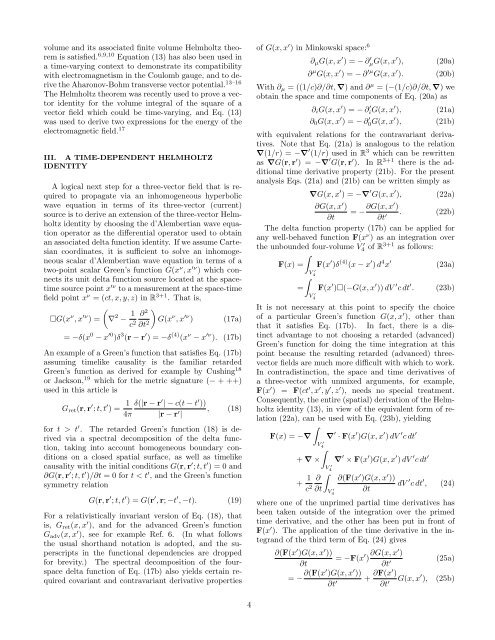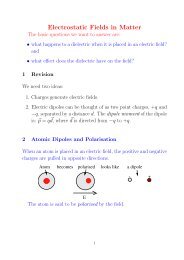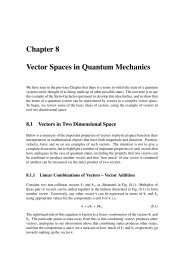Three-vector and scalar field identities and uniqueness theorems in ...
Three-vector and scalar field identities and uniqueness theorems in ...
Three-vector and scalar field identities and uniqueness theorems in ...
Create successful ePaper yourself
Turn your PDF publications into a flip-book with our unique Google optimized e-Paper software.
volume <strong>and</strong> its associated f<strong>in</strong>ite volume Helmholtz theoremis satisfied. 6,9,10 Equation (13) has also been used <strong>in</strong>a time-vary<strong>in</strong>g context to demonstrate its compatibilitywith electromagnetism <strong>in</strong> the Coulomb gauge, <strong>and</strong> to derivethe Aharonov-Bohm transverse <strong>vector</strong> potential. 13–16The Helmholtz theorem was recently used to prove a <strong>vector</strong>identity for the volume <strong>in</strong>tegral of the square of a<strong>vector</strong> <strong>field</strong> which could be time-vary<strong>in</strong>g, <strong>and</strong> Eq. (13)was used to derive two expressions for the energy of theelectromagnetic <strong>field</strong>. 17III. A TIME-DEPENDENT HELMHOLTZIDENTITYA logical next step for a three-<strong>vector</strong> <strong>field</strong> that is requiredto propagate via an <strong>in</strong>homogeneous hyperbolicwave equation <strong>in</strong> terms of its three-<strong>vector</strong> (current)source is to derive an extension of the three-<strong>vector</strong> Helmholtzidentity by choos<strong>in</strong>g the d’Alembertian wave equationoperator as the differential operator used to obta<strong>in</strong>an associated delta function identity. If we assume Cartesiancoord<strong>in</strong>ates, it is sufficient to solve an <strong>in</strong>homogeneous<strong>scalar</strong> d’Alembertian wave equation <strong>in</strong> terms of atwo-po<strong>in</strong>t <strong>scalar</strong> Green’s function G(x ν , x ′ν ) which connectsits unit delta function source located at the spacetimesource po<strong>in</strong>t x ′ν to a measurement at the space-time<strong>field</strong> po<strong>in</strong>t x ν = (ct, x, y, z) <strong>in</strong> R 3+1 . That is,□G(x ν , x ′ν ) =(∇ 2 − 1 ∂ 2 )c 2 ∂t 2 G(x ν , x ′ν ) (17a)= −δ(x 0 − x ′0 )δ 3 (r − r ′ ) = −δ (4) (x ν − x ′ν ). (17b)An example of a Green’s function that satisfies Eq. (17b)assum<strong>in</strong>g timelike causality is the familiar retardedGreen’s function as derived for example by Cush<strong>in</strong>g 18or Jackson, 19 which for the metric signature (− + ++)used <strong>in</strong> this article isG ret (r, r ′ ; t, t ′ ) = 14πδ(|r − r ′ | − c(t − t ′ ))|r − r ′ , (18)|for t > t ′ . The retarded Green’s function (18) is derivedvia a spectral decomposition of the delta function,tak<strong>in</strong>g <strong>in</strong>to account homogeneous boundary conditionson a closed spatial surface, as well as timelikecausality with the <strong>in</strong>itial conditions G(r, r ′ ; t, t ′ ) = 0 <strong>and</strong>∂G(r, r ′ ; t, t ′ )/∂t = 0 for t < t ′ , <strong>and</strong> the Green’s functionsymmetry relationG(r, r ′ ; t, t ′ ) = G(r ′ , r; −t ′ , −t). (19)For a relativistically <strong>in</strong>variant version of Eq. (18), thatis, G ret (x, x ′ ), <strong>and</strong> for the advanced Green’s functionG adv (x, x ′ ), see for example Ref. 6. (In what followsthe usual shorth<strong>and</strong> notation is adopted, <strong>and</strong> the superscripts<strong>in</strong> the functional dependencies are droppedfor brevity.) The spectral decomposition of the fourspacedelta function of Eq. (17b) also yields certa<strong>in</strong> requiredcovariant <strong>and</strong> contravariant derivative propertiesof G(x, x ′ ) <strong>in</strong> M<strong>in</strong>kowski space: 6∂ µ G(x, x ′ ) = − ∂ ′ µG(x, x ′ ),∂ µ G(x, x ′ ) = − ∂ ′µ G(x, x ′ ).(20a)(20b)With ∂ µ = ((1/c)∂/∂t, ∇) <strong>and</strong> ∂ µ = (−(1/c)∂/∂t, ∇) weobta<strong>in</strong> the space <strong>and</strong> time components of Eq. (20a) as∂ i G(x, x ′ ) = − ∂ iG(x, ′ x ′ ),∂ 0 G(x, x ′ ) = − ∂ 0G(x, ′ x ′ ),(21a)(21b)with equivalent relations for the contravariant derivatives.Note that Eq. (21a) is analogous to the relation∇(1/r) = −∇ ′ (1/r) used <strong>in</strong> R 3 which can be rewrittenas ∇G(r, r ′ ) = −∇ ′ G(r, r ′ ). In R 3+1 there is the additionaltime derivative property (21b). For the presentanalysis Eqs. (21a) <strong>and</strong> (21b) can be written simply as∇G(x, x ′ ) = −∇ ′ G(x, x ′ ),(22a)∂G(x, x ′ )= − ∂G(x, x′ )∂t∂t ′ . (22b)The delta function property (17b) can be applied forany well-behaved function F(x ν ) as an <strong>in</strong>tegration overthe unbounded four-volume V 4 ′ of R 3+1 as follows:∫F(x) = F(x ′ )δ (4) (x − x ′ ) d 4 x ′(23a)∫=V 4′V ′4F(x ′ )□(−G(x, x ′ )) dV ′ c dt ′ .(23b)It is not necessary at this po<strong>in</strong>t to specify the choiceof a particular Green’s function G(x, x ′ ), other thanthat it satisfies Eq. (17b). In fact, there is a dist<strong>in</strong>ctadvantage to not choos<strong>in</strong>g a retarded (advanced)Green’s function for do<strong>in</strong>g the time <strong>in</strong>tegration at thispo<strong>in</strong>t because the result<strong>in</strong>g retarded (advanced) three<strong>vector</strong><strong>field</strong>s are much more difficult with which to work.In contradist<strong>in</strong>ction, the space <strong>and</strong> time derivatives ofa three-<strong>vector</strong> with unmixed arguments, for example,F(x ′ ) = F(ct ′ , x ′ , y ′ , z ′ ), needs no special treatment.Consequently, the entire (spatial) derivation of the Helmholtzidentity (13), <strong>in</strong> view of the equivalent form of relation(22a), can be used with Eq. (23b), yield<strong>in</strong>g∫F(x) = −∇ ∇ ′ · F(x ′ )G(x, x ′ ) dV ′ c dt ′V 4′∫+ ∇ ×+ 1 c 2 ∂∂tV 4′∫V ′4∇ ′ × F(x ′ )G(x, x ′ ) dV ′ c dt ′∂(F(x ′ )G(x, x ′ ))∂tdV ′ c dt ′ , (24)where one of the unprimed partial time derivatives hasbeen taken outside of the <strong>in</strong>tegration over the primedtime derivative, <strong>and</strong> the other has been put <strong>in</strong> front ofF(x ′ ). The application of the time derivative <strong>in</strong> the <strong>in</strong>tegr<strong>and</strong>of the third term of Eq. (24) gives∂(F(x ′ )G(x, x ′ ))∂t= −F(x ′ ) ∂G(x, x′ )∂t ′(25a)= − ∂(F(x′ )G(x, x ′ ))∂t ′ + ∂F(x′ )∂t ′ G(x, x ′ ), (25b)4
















